使用Matplotlib & Cartopy绘制我国台风路径图

夏天一到,沿海地区经常会遭到台风的袭扰,可谓苦不堪言。
之前在公众号做过一个关于我国1945~2015年历史台风统计的可视化展示,发现很多有趣的数据,比如说台风登陆最多的城市是湛江。

大家可以去翻看历史文章,附有完整代码和数据,有兴趣做些可视化探索。
这次的文章不研究台风数据,而是尝试用Python来绘制台风路径。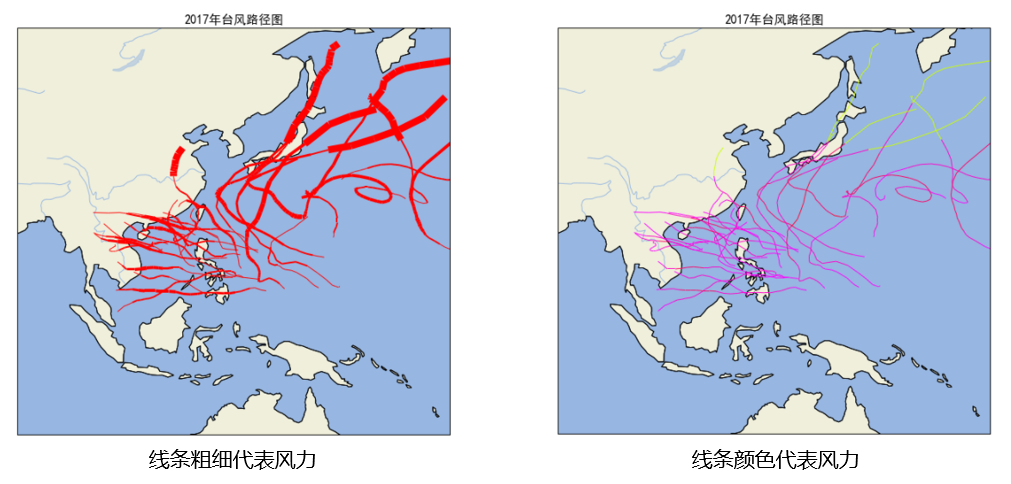
主要第三方库
用到的主要工具包有pandas、numpy、matplotlib、cartopy、shapely,前三个库大家可能都熟悉,下面介绍下后两个库的使用场景。
❝❞
cartopy:基于matplotlib的python地理数据处理和可视化库,本文会用来展示地图shapely: 是一个对几何对象进行操作和分析的Python库,本文用来处理点线数据
cartopy文档:https://scitools.org.uk/cartopy/docs/latest/ shapely文档:https://shapely.readthedocs.io/en/stable/
台风路径数据
本文用到的数据是我国2017年所有台风路径,包含了时间、经纬度、强度等关键信息。
由于数据来源网络,没法追溯真实性,仅供练习。
原始数据比较乱,我重新处理了方便使用: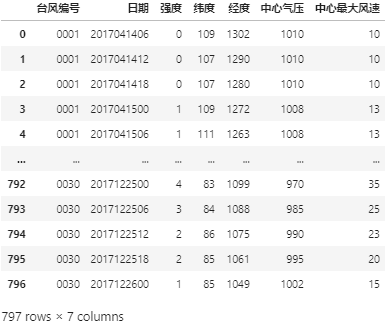
可以看到共有7个字段:
❝台风编号:我国热带气旋编号
日期:具体时间
强度:0~9
纬度:单位0.1度
经度:单位0.1度
中心气压:hPa
中心最大风速:m/s
❞
绘制地图
台风路径需要在地图上展示,那么如何获取地图呢?
方式有很多种,既可以用离线的GeoJson数据,也可以用JPG图片,或者第三方库提供的地图。
我这里用的是cartopy内置的地图数据,可以很方便的修改配置属性。
首先导入本次会用到的所有库:
# cartopy:用来获取地图
import cartopy.crs as ccrs
import cartopy.feature as cfeature
# matplotlib:用来绘制图表
import matplotlib.pyplot as plt
# shapely:用来处理点线数据
import shapely.geometry as sgeom
import warnings
import re
import numpy as np
import pandas as pd
warnings.filterwarnings('ignore')
plt.rcParams['font.sans-serif'] = [u'SimHei']
plt.rcParams['axes.unicode_minus'] = False
获取我国沿海区域地图:
# 通过cartopy获取底图
fig = plt.figure(figsize=(10,10))
ax = fig.add_subplot(1, 1, 1, projection=ccrs.PlateCarree())
# 用经纬度对地图区域进行截取,这里只展示我国沿海区域
ax.set_extent([85,170,-20,60], crs=ccrs.PlateCarree())
# 设置名称
ax.set_title('2017年台风路径图',fontsize=16)
# 设置地图属性,比如加载河流、海洋
ax.add_feature(cfeature.LAND)
ax.add_feature(cfeature.OCEAN)
ax.add_feature(cfeature.COASTLINE)
ax.add_feature(cfeature.RIVERS)
ax.add_feature(cfeature.COASTLINE)
ax.add_feature(cfeature.LAKES, alpha=0.5)
# 展示地图
plt.show()
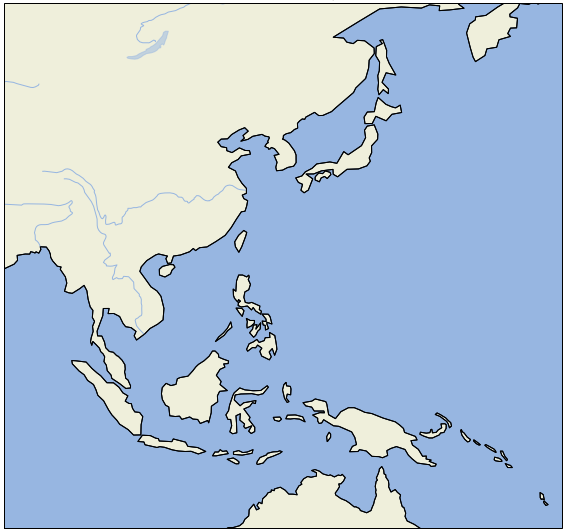
处理数据并可视化
先加载数据:
typhoonData = pd.read_csv('typhoonData.csv')

这个数据集包含了30个台风路径,所以后面要分别进行可视化。
再对数据进行处理,依次提取单个台风路径及其经纬度。
# 先对台风编号进行循环,提取单个台风数据
for typhoonNumber in typhoonData['台风编号'].unique():
typhoon = typhoonData[typhoonData['台风编号']==typhoonNumber]
# 再对单个台风数据进行处理,提取经纬度
for typhoonPoint in np.arange(len(typhoon)-1):
lat_1 = typhoon.iloc[typhoonPoint,3]/10
lon_1 = typhoon.iloc[typhoonPoint,4]/10
lat_2 = typhoon.iloc[typhoonPoint+1,3]/10
lon_2 = typhoon.iloc[typhoonPoint+1,4]/10
point_1 = lon_1,lat_1
point_2 = lon_2,lat_2
# 最后可视化
ax.add_geometries([sgeom.LineString([point_1,point_2])],crs=ccrs.PlateCarree(),edgecolor='red')
# 展示图像
plt.show()
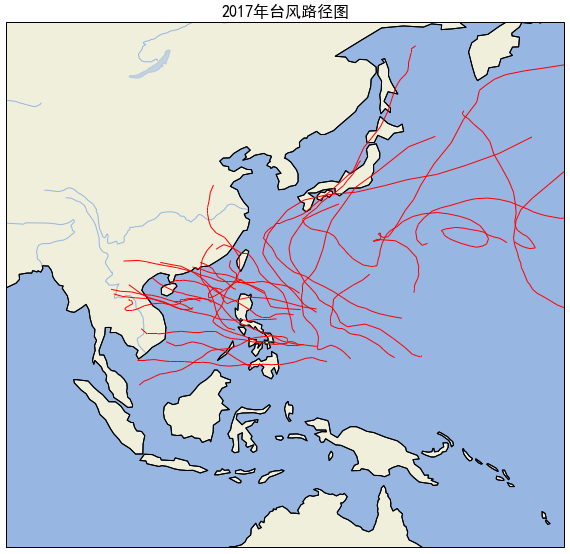
能看到所有台风路径都被描绘出来了。
但这里没有区别显示台风强度,一般是在.add_geometries()方法中添加参数调整。
有两种方式:
用颜色区别:不同颜色代表不同强度,参数-edgecolor 用线条粗细区别:越粗则强度越高,参数-linewidth
颜色区分
# 按强度区分颜色
def get_color(level):
if level in (0,1):
color='#ff00ff'
elif level in (2,3):
color='#ff00cc'
elif level in (4,5):
color='#ff0066'
elif level in (6,7):
color='#ff0033'
elif level in (8,9):
color='#ccff00'
return color
# 先对台风编号进行循环,提取单个台风数据
for typhoonNumber in typhoonData['台风编号'].unique():
typhoon = typhoonData[typhoonData['台风编号']==typhoonNumber]
# 再对单个台风数据进行处理,提取经纬度
for typhoonPoint in np.arange(len(typhoon)-1):
lat_1 = typhoon.iloc[typhoonPoint,3]/10
lon_1 = typhoon.iloc[typhoonPoint,4]/10
lat_2 = typhoon.iloc[typhoonPoint+1,3]/10
lon_2 = typhoon.iloc[typhoonPoint+1,4]/10
point_1 = lon_1,lat_1
point_2 = lon_2,lat_2
# 最后可视化,添加颜色参数
ax.add_geometries([sgeom.LineString([point_1,point_2])],crs=ccrs.PlateCarree(),edgecolor=get_color(typhoon.iloc[typhoonPoint,2]))
# 展示图像
plt.show()
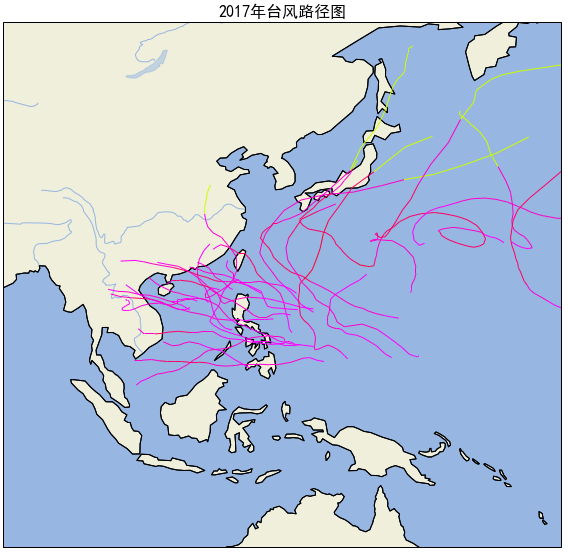
线条粗细区分
# 先对台风编号进行循环,提取单个台风数据
for typhoonNumber in typhoonData['台风编号'].unique():
typhoon = typhoonData[typhoonData['台风编号']==typhoonNumber]
# 再对单个台风数据进行处理,提取经纬度
for typhoonPoint in np.arange(len(typhoon)-1):
lat_1 = typhoon.iloc[typhoonPoint,3]/10
lon_1 = typhoon.iloc[typhoonPoint,4]/10
lat_2 = typhoon.iloc[typhoonPoint+1,3]/10
lon_2 = typhoon.iloc[typhoonPoint+1,4]/10
point_1 = lon_1,lat_1
point_2 = lon_2,lat_2
# 最后可视化
ax.add_geometries([sgeom.LineString([point_1,point_2])],crs=ccrs.PlateCarree(),linewidth = typhoon.iloc[typhoonPoint,2],edgecolor='red')
# 展示图像
plt.show()
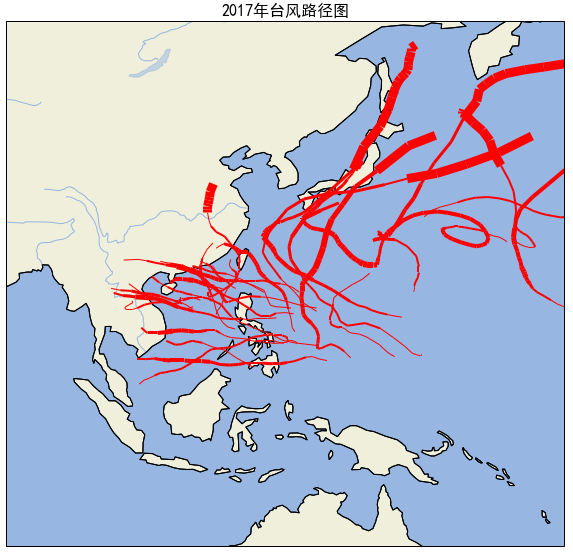
最后
上文用比较简单的方式绘制了台风路径图,大家可以尝试换个三维地图,或者用动态显示台风走势...
玩法挺多的,赶紧尝试尝试吧。
❝后台回复:t,获取数据集和完整代码
❞

加入知识星球【我们谈论数据科学】
400+小伙伴一起学习!
· 推荐阅读 ·
